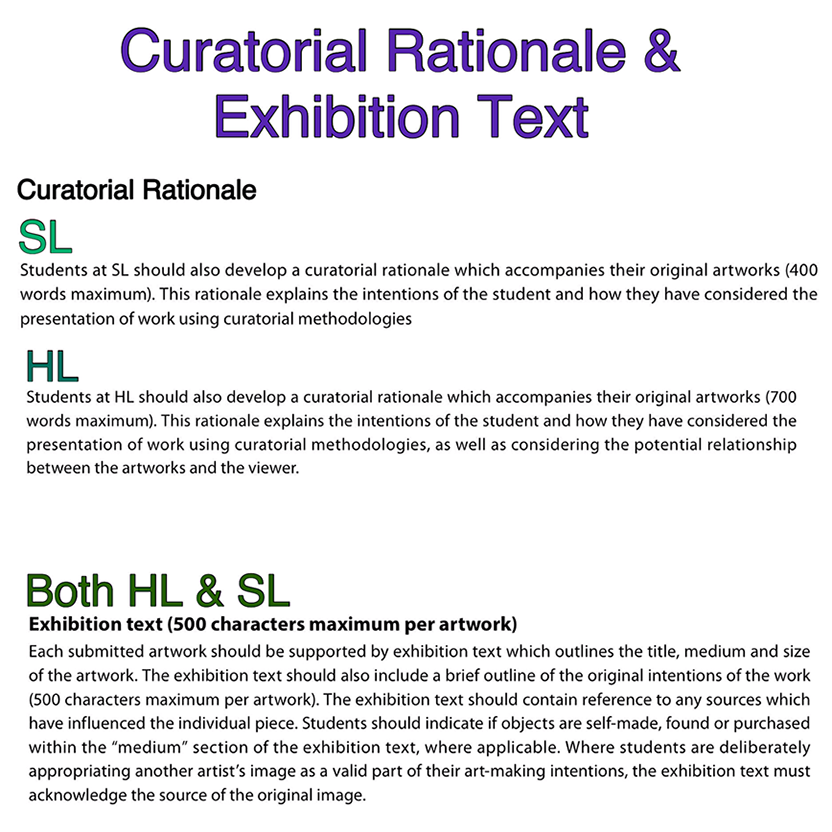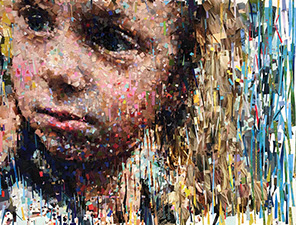CURATORIAL RATIONAL & EXHIBITION TEXT
From Jessica Russo Scherr:
IB EXHIBITION TEXT & CURATORIAL RATIONALE
What is an artist statement/curatorial rationale? A general introduction of your work as an artist.
The what, how, and why of your work, from your own point of view. Meaning or purpose of your work to the audience. Keep your sentences authentic and direct. Use the present tense ("I am," not "I was," "I do," not "I did.")
- Be brave: say nice things about yourself.
- Eloquent but Concise
- Avoid jargon-filled, pretentious baloney!
- Keep it simple and tell the truth
SUGGESTED LAYOUT
First Paragraph
Begin with an overview paragraph that makes a clear and concise statement about your work. Support that statement, telling the reader more about your goals and aspirations. This paragraph should be broad in scope. Specifics will come next.
Second Paragraph
Point out themes in your work or discuss experiences that have influenced your work. Discuss research and influential artists that you reference in your artwork. How do you make decisions in the course of your work? Why you use the materials/techniques and tools that you do. Go into detail (offer a specific example).
Third Paragraph
Tell the reader a little more about your current work. How it grew out of prior work or life experiences. What are you exploring, attempting, challenging by doing this work. Justify your selection, arrangement and the exhibition of artworks “within a designated space” (curatorial methodologies). Reflect on how your exhibition conveys an understanding of the relationship between the artworks and the viewer. Finally, sum up the most important points made throughout previous paragraphs.
WHAT ARE CURATORIAL METHODOLOGIES?
Organize your work by:
- Theme
- Techniques To tell a story
- Create an experience To juxtapose certain works together
- How close or spread out the works are placed.
- Works placed in a series?
- Font, size and placement of your exhibition text.
- Creating a unified display of work.
Having trouble writing? Begin by brainstorming:
1. Take five minutes and think about why you do what you do.
2. Make a list of words and phrases that communicate your feelings about your work and your values. Include words you like, words that make you feel good, words that communicate your values or fascinations. Be loose. Be happy. Be real.
3. Answer these questions as simply as you can. Let them be raw and uncut for now.
- What is your favorite tool? Why?
- What is your favorite material? Why?
- What do you like best about what you do?
- What do you mean when you say that a piece has turned out really well?
- What patterns emerge in your work? Is there a pattern in the way you select materials? In the way you use color, texture or light?
- What do you do differently from the way you were taught? Why?
- What is your favorite color? List three qualities of the color. Consider that these qualities apply to your work.
4. Look at your word list. Add new words suggested by your answers to the questions above.
5. Choose two key words from your word list. They can be related or entirely different. Look them up in a dictionary. Read all the definitions listed for your words. Copy the definitions, thinking about what notions they have in common. Look your words up in a Thesaurus. Read the entries related to your words. Are there any new words that should be added to your word list?
6. Write five sentences that tell the truth about your connection to your work. If you are stuck, start by filling in the blanks below.
- When I work with__________ I am reminded that___________.
- I begin a piece by______________.
- I know a piece is done when__________________.
- When my work is going well, I am filled with a sense of _____________.
- When people see my work, I'd like them to ________________.
7. Ask yourself questions about your work:
- Why you have created the work and what is its history?
- Your overall vision-- what are you trying to say in the work?
- How does your current work relate to your previous work?
- What influences your work?
- What is your inspiration for your images?
- How does this work fit into a series or larger body of work?
- Create a list of words and phrases that describe your chosen themes, your artistic values, creation process, and influences (i.e. experiences, dreams). Draw from your answers from the previous step.
- Edit down your list of words and begin creating sentences using those words.
Tips and layout a my personal suggestions and altered from http://www.mollygordon.com/resources/marketingresources/artstatemt/
and


Jessica Russo Scherr
“A Moment with Siena”
Collage 50x70 cm
This collage, made from overlapping rectangles cut from magazines, depicts my daughter. My intention is to capture the dichotomy between her child-like qualities and her complicated maturity. I incorporated more detail and realism in her gaze, while the rest breaks out of representation into abstraction, where borders and planes deconstruct into color and pattern. The physicality of Jenny Saville’s “Reverse” is a major influence on this work.

Comments
Post a Comment